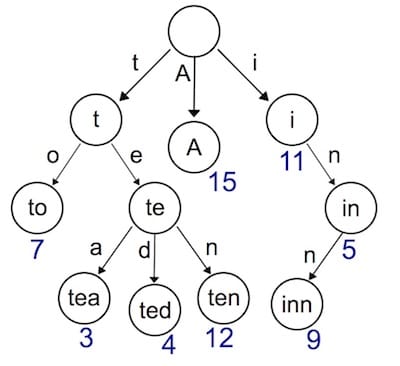3. 前缀树路由
...大约 4 分钟
1. 前缀树 Trie
使用哈希表的路由表,只能处理静态路由。
对于动态路由,例如:/hello/:name,可以使用前缀树的数据结构实现。

HTTP的请求路径是以/进行分隔的,因此每段可以作为 Trie 的节点。

2. 实现动态路由
使用前缀树实现动态路由的以下功能:
- 参数匹配
:,例如:/:lang/doc,可以匹配/clang/doc,/go/doc - 通配符
*,例如:/static/*filepath,可以匹配static/fav.ico,static/js/jQuery.js
https://github.com/dreamjz/golang-notes/tree/main/books/7-days-golang/Gee/day3-tire-router
当前项目结构:
DAY3-TIRE-ROUTER
│ go.mod
│ go.work
│ main.go
│
└─gee
context.go
gee.go
go.mod
router.go
router_test.go
trie.go
2.1 Trie
package gee
import "strings"
type trieNode struct {
pattern string // 待匹配的路由
part string // 当前节点的内容
children []*trieNode // 子节点
isWild bool // 是否进行精准匹配,默认 false
}
// 寻找第一个匹配成功的节点,用于插入
func (n *trieNode) matchChild(part string) *trieNode {
for _, child := range n.children {
if child.part == part || child.isWild {
return child
}
}
return nil
}
// 寻找所有匹配成功的节点,用于查找
func (n *trieNode) matchChildren(part string) []*trieNode {
nodes := make([]*trieNode, 0)
for _, child := range n.children {
if child.part == part || child.isWild {
nodes = append(nodes, child)
}
}
return nodes
}
// 向前缀树中插入新节点
func (n *trieNode) insert(pattern string, parts []string, depth int) {
if len(parts) == depth {
n.pattern = pattern
return
}
part := parts[depth]
child := n.matchChild(part)
if child == nil {
child = &trieNode{part: part, isWild: part[0] == ':' || part[0] == '*'}
n.children = append(n.children, child)
}
child.insert(pattern, parts, depth+1)
}
// 查找指定路由对应的节点
func (n *trieNode) search(parts []string, depth int) *trieNode {
if len(parts) == depth || strings.HasPrefix(n.part, "*") {
if n.pattern == "" {
return nil
}
return n
}
part := parts[depth]
children := n.matchChildren(part)
for _, child := range children {
res := child.search(parts, depth+1)
if res != nil {
return res
}
}
return nil
}
trieNode:前缀树的节点pattern:已注册的路由,空字符串表示根节点到此节点的路径不是注册的路由isWild:是否使用精准匹配,默认 false- 当出现
:和*表示此路由为动态路由,为 true
- 当出现
2.2 Router
package gee
import (
"net/http"
"strings"
)
type router struct {
trieRoots map[string]*trieNode
handlers map[string]HandlerFunc
}
func newRouter() *router {
return &router{
trieRoots: map[string]*trieNode{},
handlers: map[string]HandlerFunc{},
}
}
func parsePattern(pattern string) []string {
strs := strings.Split(pattern, "/")
parts := make([]string, 0)
for _, str := range strs {
if str != "" {
parts = append(parts, str)
if str[0] == '*' { // Only one '*' allowed
break
}
}
}
return parts
}
func (r *router) addRoute(method string, pattern string, handler HandlerFunc) {
parts := parsePattern(pattern)
_, ok := r.trieRoots[method]
if !ok {
r.trieRoots[method] = &trieNode{}
}
r.trieRoots[method].insert(pattern, parts, 0)
key := method + "-" + pattern
r.handlers[key] = handler
}
func (r *router) handle(c *Context) {
n, params := r.getRoute(c.Method, c.Path)
if n != nil {
c.Params = params
key := c.Method + "-" + n.pattern
r.handlers[key](c)
} else {
c.String(http.StatusNotFound, "404 NOT FOUND: %s\n", c.Path)
}
}
func (r *router) getRoute(method string, path string) (*trieNode, map[string]string) {
root, ok := r.trieRoots[method]
if !ok {
return nil, nil
}
searchParts := parsePattern(path)
n := root.search(searchParts, 0)
if n != nil {
parts := parsePattern(n.pattern)
params := make(map[string]string)
for i, part := range parts {
if part[0] == ':' {
params[part[1:]] = searchParts[i]
}
if part[0] == '*' && len(part) > 1 {
params[part[1:]] = strings.Join(searchParts[i:], "/")
break
}
}
return n, params
}
return nil, nil
}
routertrieRoots:路由前缀树根节点,不同的方法类型对应不同的路由hadnlers:路由处理函数,方法类型+请求路径映射到唯一的处理函数
parsePattern:将注册的路由按照/分割为多个部分,不会添加空字符串并且只允许一个通配符*addRoute:向路由表中添加路由- 将路由插入到前缀树中
- 添加处理函数到哈希表中
getRoute:根据请求路径,获取对应的路由及其路由参数handle:处理请求,根据请求路径获取绑定的处理函数并调用
2.3 Context
type Context struct {
Writer http.ResponseWriter
Req *http.Request
// Request info
Path string
Method string
Params map[string]string // Dynamic route parameters
// Response info
StatusCode int
}
Params:当前请求的路由参数哈希表
// Param return dynamic route parameter by key
func (c *Context) Param(key string) string {
val, _ := c.Params[key]
return val
}
获取当前请求的路由参数
3. 测试
3.1 单元测试
package gee
import (
"fmt"
"reflect"
"testing"
)
func TestParsePattern(t *testing.T) {
type args struct {
pattern string
}
tests := []struct {
name string
args args
want []string
}{
{name: "Empty String", args: args{pattern: ""}, want: []string{}},
{name: "Empty Pattern", args: args{pattern: "/"}, want: []string{}},
{name: "Empty Pattern", args: args{pattern: "//"}, want: []string{}},
{name: "Dynamic route parameter", args: args{pattern: "p/:name"}, want: []string{"p", ":name"}},
{name: "Wildcard ", args: args{pattern: "p/*"}, want: []string{"p", "*"}},
{name: "Multiple wildcards", args: args{pattern: "p/*name/*"}, want: []string{"p", "*name"}},
}
for _, tt := range tests {
t.Run(tt.name, func(t *testing.T) {
if got := parsePattern(tt.args.pattern); !reflect.DeepEqual(got, tt.want) {
t.Errorf("parsePattern(%q) = %v, want: %v", tt.args.pattern, got, tt.want)
}
})
}
}
func newTestRouter() *router {
r := newRouter()
r.addRoute("GET", "/", nil)
r.addRoute("GET", "/hello/:name", nil)
r.addRoute("GET", "/hello/:name/getAge", nil)
r.addRoute("GET", "/hello/b/c", nil)
r.addRoute("GET", "/hi/:name", nil)
r.addRoute("GET", "/assets/*filepath", nil)
return r
}
func TestGetRoute(t *testing.T) {
r := newTestRouter()
n, params := r.getRoute("GET", "/hello/alice")
switch {
case n == nil:
t.Fatal("TrieNode cannot be nil")
case n.pattern != "/hello/:name":
t.Fatal("Route should match /hello/:name")
case params["name"] != "alice":
t.Fatal("Route parameter name should be alice")
default:
fmt.Printf("mathched path: %q, params['name']: %q\n", n.pattern, params["name"])
}
}
3.2 启动Demo
func main() {
r := gee.New()
r.GET("/", func(c *gee.Context) {
c.HTML(http.StatusOK, "<h1>Welcome</h1>")
})
r.GET("/hello", func(c *gee.Context) {
c.String(http.StatusOK, "Hello %s, you're at %s\n", c.Query("name"), c.Path)
})
r.GET("/hello/:name", func(c *gee.Context) {
c.String(http.StatusOK, "Hello %s, you're at %s\n", c.Param("name"), c.Path)
})
r.GET("assets/*filepath", func(c *gee.Context) {
c.JSON(http.StatusOK, gee.H{"filepath": c.Param("filepath")})
})
r.Run(":8000")
}
$ curl http://localhost:8000
<h1>Welcome</h1>
$ curl http://localhost:8000/hello?name=alice
Hello alice, you're at /hello
$ curl http://localhost:8000/hello/alice
Hello alice, you're at /hello/alice
$ curl http://localhost:8000/assets/css/layout.css
{"filepath":"css/layout.css"}
$ curl http://localhost:8000/AA
404 NOT FOUND: /AA
4. 小结
通过前缀树实现了动态路由
Reference
Powered by Waline v2.15.2
